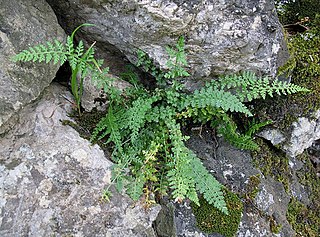
Asplenium is a genus of about 700 species of ferns, often treated as the only genus in the family Aspleniaceae, though other authors consider Hymenasplenium separate, based on molecular phylogenetic analysis of DNA sequences, a different chromosome count, and structural differences in the rhizomes. The type species for the genus is Asplenium marinum.

Asplenium bulbiferum, known as mother spleenwort, is a fern species native to New Zealand only. It is also called hen and chicken fern and, in the Māori language, pikopiko, mouku or mauku. Its fronds are eaten as a vegetable.

Asplenium rhizophyllum, the (American) walking fern, is a frequently-occurring fern native to North America. It is a close relative of Asplenium ruprechtii which is found in East Asia and also goes by the common name of "walking fern".
Asplenium ruprechtii, which goes by the common name Asian Walking Fern, is a rare, hardy, low-lying fern native to East Asia. It is a close relative of Asplenium rhizophyllum which is found in North America and also goes by the common name of walking fern. The species should not be confused with Asplenium sibiricum which is a synonym of Diplazium sibiricum.

Asplenium trichomanes, the maidenhair spleenwort, is a small fern in the spleenwort genus Asplenium. It is a widespread and common species, occurring almost worldwide in a variety of rocky habitats. It is a variable fern with several subspecies.

Asplenium septentrionale is a species of fern known by the common names northern spleenwort and forked spleenwort. It is native to Europe, Asia and western North America, where it grows on rocks. Its long, slender leaves give it a distinctive appearance. Three subspecies exist, corresponding to a tetraploid and a diploid cytotype and their triploid hybrid.

Asplenium flaccidum is a species of fern in the family Aspleniaceae. The plant common name is drooping spleenwort or weeping spleenwort, and the species name flaccidum derives from the Latin root meaning drooping. An example occurrence of A. flaccidum is within a Nothofagus-Podocarp forest at Hamilton Ecological District on New Zealand's North Island in association with other fern species understory plants, crown fern, Blechnum discolor being an example.

Asplenium australasicum, the bird's nest fern or crow's nest fern, is an epiphytic Australasian species of fern in the family Aspleniaceae.

Asplenium montanum, commonly known as the mountain spleenwort, is a small fern endemic to the eastern United States. It is found primarily in the Appalachian Mountains from Vermont to Alabama, with a few isolated populations in the Ozarks and in the Ohio Valley. It grows in small crevices in sandstone cliffs with highly acid soil, where it is usually the only vascular plant occupying that ecological niche. It can be recognized by its tufts of dark blue-green, highly divided leaves. The species was first described in 1810 by the botanist Carl Ludwig Willdenow. No subspecies have been described, although a discolored and highly dissected form was reported from the Shawangunk Mountains in 1974. Asplenium montanum is a diploid member of the "Appalachian Asplenium complex," a group of spleenwort species and hybrids which have formed by reticulate evolution. Members of the complex descended from A. montanum are among the few other vascular plants that can tolerate its typical habitat.

Asplenium bradleyi, commonly known as Bradley's spleenwort or cliff spleenwort, is a rare epipetric fern of east-central North America. Named after Professor Frank Howe Bradley, who first collected it in Tennessee, it may be found infrequently throughout much of the Appalachian Mountains, the Ozarks, and the Ouachita Mountains, growing in small crevices on exposed sandstone cliffs. The species originated as a hybrid between mountain spleenwort and ebony spleenwort ; A. bradleyi originated when that sterile diploid hybrid underwent chromosome doubling to become a fertile tetraploid, a phenomenon known as allopolyploidy. Studies indicate that the present population of Bradley's spleenwort arose from several independent doublings of sterile diploid hybrids. A. bradleyi can also form sterile hybrids with several other spleenworts.

Asplenium viride is a species of fern known as the green spleenwort because of its green stipes and rachides. This feature easily distinguishes it from the very similar-looking maidenhair spleenwort, Asplenium trichomanes.

Asplenium oblongifolium is a native species of fern from New Zealand. The plant's common name is shining spleenwort and its Māori name is huruhuruwhenua. A. oblongifolium is found on the North, South, Chatham and Kermadec Islands, and is found from the coast to the mountains.

Asplenium milnei is a ground fern only found on Lord Howe Island. Commonly seen in lowland areas.
Asplenium pteridoides is a species of terrestrial fern in the family Aspleniaceae. It is endemic to Australia's subtropical Lord Howe Island in the Tasman Sea. It is restricted to the cool, moist understorey of the forest on the island's southern mountains.

Asplenium surrogatum is a species of fern in the family Aspleniaceae. It is endemic to Australia's subtropical Lord Howe Island in the Tasman Sea. It grows both terrestrially and as an epiphyte. It occurs in forest at high elevations on the island's mountains.

Asplenium difforme is a plant in the spleenwort group of ferns. Its habitat is cracks in rocky headlands beside the sea. It is found in eastern Australia and Norfolk Island. Its fronds are thick and waxy to protect it from sea spray.

Asplenium appendiculatum, ground spleenwort, is a common native fern to Australia and New Zealand. It usually grows in cool damp conditions, among rocks, on logs or as an epiphyte.

Asplenium fontanum, commonly known as fountain spleenwort or smooth rock spleenwort, is a species of fern in the family Aspleniaceae, native to rocky areas in Western Europe.

Asplenium gracillimum is a fern species native to Australia and New Zealand, also found in Stewart Island and the Chatham Islands. The specific epithet gracillimum refers to the slender and graceful appearance of this fern.
















